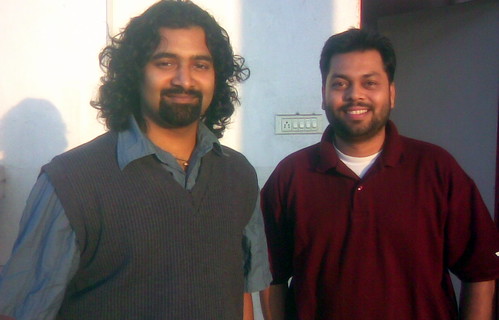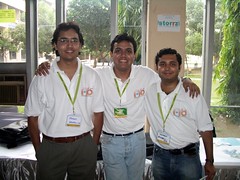Nevis Networks, a mostly-Pune-based-company (with “official” headquarters in the US, and an additional center in China), builds network switches and other network hardware that allows a company to secure it’s internal network from attacks and to enforce identity-based security policies. The company’s LANenforcer product family transparently protects the network from external malicious attacks, and also allows restricting access to different network resources based on users’ identities according to policies set by the system administrators. This can be customized to ensure different levels of access to different classes of users, employees, contractors, guests and other third parties. In addition, the product allows detailed reporting, auditing, employee activity reports that make it possible to analyze security breaches in very granular detail. And because it is hardware based, all of this is delivered in realtime with very low latency.
Nevis Networks’ customers range from financial services, healthcare, education and defense contractors and they deploy Nevis LANenforcers to protect sensitive network resources and assets, with an intention of reducing the overall costs and time to resolve security breaches and conduct network audits. The company is headquartered in Mountain View, CA, with additional R&D centers in Pune, India and Beijing, China.
The ongoing recession has hit Nevis Networks hard, and it downsized a very large fraction of its workforce late last year. On top of that, on Monday, in a report title “LSI Acquires Manpower Team of Navis Networking”, CXOToday implied that the company (which they alternately identified as Navis Networks or Nevis Networks in the article) had shutdown and the team taken over by LSI. Specifically, this is what CXOToday said:
With recession being an opportunity to invest for big MNCs, LSI Technologies, a provider of innovative silicon, systems and software technologies has acquired the team of Navis Networking based at Pune. With the R&D unit based out of Mountain View, California shutting down, LSI has acquired the manpower of the captive R&D centre in India.
After hearing from PuneTech readers that this report is misleading, we caught up with Ajit Shelat, Senior Vice President of Engineering for Nevis Networks, to learn that the reports of Nevis’ demise have been greatly exaggerated. Here is a quick report of the conversation we had with Ajit:
On the news that LSI has “acquired” the “manpower” of Nevis but not the company.
The report by CXOToday is misleading. What actually happened is much simpler. Due to the economic downturn last year, Nevis Networks was looking to downsize some of its workforce. A friendly interaction between the respective managements of Nevis and LSI led to movement of some of Nevis manpower to LSI. This was a simple case of Nevis ex-employees being hired by LSI en masse. It does not represent any sort of acquisition or even agreement between Nevis and LSI. And these are certainly not the entire team of Nevis Networks India, as implied by the CXOToday article.
In any case, Nevis networks is not shutting down. It continues to execute on a with strategy and focus.
On the current status of Nevis Networks
Nevis networks core team is still there and it is going strong. In fact, the last quarter was quite good and has been the best quarter for Nevis since the inception of the company.
What has happened is that due to the downturn, Nevis shifted its focus away from the US market to the India and China markets, reduced its workforce in the US and in India, and this new strategy appears to be working for them.
On the surprising fact that India/China are better markets than the US market
Since Nevis Networks is selling cutting edge technology, one would have expected US to be the logical market for these products. However, people really underestimate the extent of the effect the economic recession is having on the market there. While the markets really melted around September 2008, the signs have been obvious for at least an year before that, and starting Nov/Dec 2007, Nevis had started planning its strategy of shifting focus away from the US market to the India/China markets.
In tune with their new strategy, Nevis substantially reduced its India workforce. They continue to support existing customers in the US, but new customers are coming mainly from India – which is apparently not affected by the recession as much. In general, it is easier for a company with mainly Indian promoters to sell in India than in other countries.
China is another country where sales are expected to grow – Nevis is in the process of stengthening its sales presence in China. The Chinese market, having a significantly different character, takes a longer ramp up time to achieve its full potential – though a very good start has been made in terms of immediate sales. Like other markets, achieving full potential is really a function of getting the right people on the ground, and building the right relationships and customer confidence. All this effort is justified by the fact that the Chinese market has the potential to scale up dramatically.
More about Nevis Networks
Nevis Networks was founded in 2002 with the intention of building a network security solution with high speed and low latency, using its proprietary ASIC-based technology. As of last year, Nevis had raised a total of US$40 million in three rounds of funding from premier venture capital firms New Enterprise Associates, BlueRun Ventures (formerly Nokia Venture Partners) and New Path Ventures LLC. We are told that their funding situation has recently changed and an announcement to this effect is expected in the next couple of weeks.
Related articles by Zemanta
- Telsima, WiMAX Gear Maker Sold For Next-To-Nothing (gigaom.com)
- What India’s Talent Shortage Means for the US (blogs.harvardbusiness.org)
- IT Security: Blaming the Victim (schneier.com)
- Computer Virus Epidemiology (schneier.com)
- Breach Notification Laws (schneier.com)

![Reblog this post [with Zemanta]](http://img.zemanta.com/reblog_b.png?x-id=a94ed4f5-a95b-4b6a-b4fb-d6261e766fe4)

![Reblog this post [with Zemanta]](http://img.zemanta.com/reblog_b.png?x-id=b6e5f10d-f852-4b07-b84b-27f04d69de1c)


![Reblog this post [with Zemanta]](http://img.zemanta.com/reblog_b.png?x-id=1f52eb9a-952b-4003-a9db-914a70fad31a)
 Last Saturday, the
Last Saturday, the 
![Reblog this post [with Zemanta]](http://img.zemanta.com/reblog_b.png?x-id=45d6e635-e6a7-436f-b1e5-bc624d74df4b)


![Reblog this post [with Zemanta]](http://img.zemanta.com/reblog_b.png?x-id=29205d65-ced4-4616-a9e1-10d812bdcbb3)